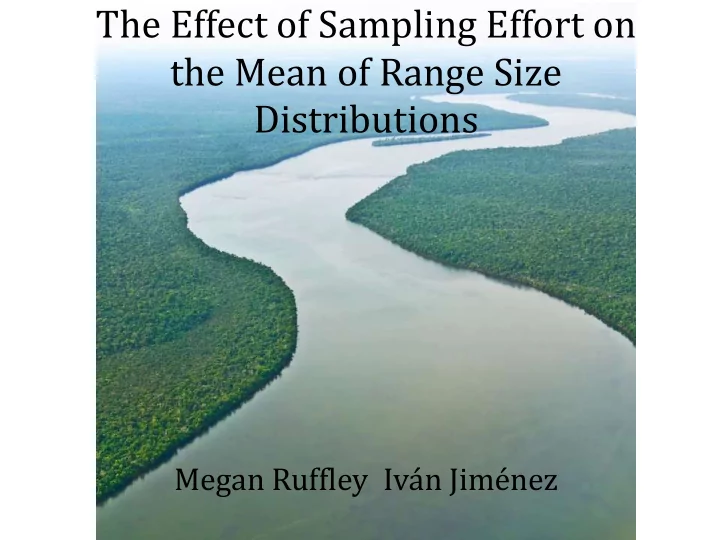

The Effect of Sampling Effort on the Mean of Range Size Distributions Megan Ruffley Iván Jiménez
Talk Outline • Introduction • Working Hypothesis • Methods – Study System – Quantification of Sampling Effort – Computer Simulation Experiment • Results • Conclusions & Implications
Species’ Range Size Distributions # of Species Gaston, 2003 Range Size
Species’ Range Size Distributions Mean of Range Size Distribution # of Species Range Size
Species’ Range Size Distributions # of Species Range Size
Species’ Range Size Distributions Mean of Range Size Distribution 1 Mean of Range Size # of Species Distribution 2 Range Size
Conservation Priority Region Mean Range Size
Means of Range Size Distributions for Vascular Plants Morueta-Holme, et al. 2013
Talk Outline • Introduction • Working Hypothesis • Methods – Study System – Quantification of Collection Effort – Computer Simulation Experiment • Results • Conclusions & Implications
Working Hypothesis A quantitative model that relates the effects of sampling effort to bias in estimates of the mean of range size distributions. Where P.m is the probability of not discovering a species, d is detectability, Ci is sampling effort, AOO is geographic range size measured as area of occupancy
Working Hypothesis X X latitude X X X longitude
Working Hypothesis X X X X X X X X X X X X X X X Sampling Effort
Working Hypothesis Bias in Estimates of the Mean of Range Size Distributions is defined as: (Mean Range Size of discovered species – Mean Range Size of all species)
Working Hypothesis X X X X X X X X X X X X X X X Sampling Effort
Working Hypothesis • Prediction 1 : As mean sampling effort increases, the bias in the estimate of the mean of range size distributions will decrease. Bias in Estimate of the Mean of RSD Mean Sampling Effort
X X X X Aggregation in Sampling Effort X X X X X X X X X X X X X X X X X X X X X X X X X X X Sampling Effort
Working Hypothesis • Prediction 2 : As spatial aggregation in sampling effort increases, the bias in the estimate of the mean of range size distributions will increase. Bias in Estimate of the Mean of RSD Spatial Aggregation in Sampling Effort
Talk Outline • Introduction • Working Hypothesis • Methods – Study System – Quantification of Collection Effort – Computer Simulation Experiment • Results • Conclusions & Implications
Study System
Talk Outline • Introduction • Working Hypothesis • Methods – Study System – Quantification of Sampling Effort – Computer Simulation Experiment • Results • Conclusions & Implications
Quantification of Sampling effort • Collector Days = unique • 986,107 herbarium specimen combinations of collector name records used and collection date (Sheth, et al. 2012)
Quantification of Sampling effort 10 km X X X X 10 km X X X X X latitude X X X X X X X X X X X X longitude
Quantification of Sampling effort 10 x 10km cells
Quantification of Sampling effort
Quantification of Sampling effort Relative Frequency of 100 x 100km cells Mean Sampling Effort
Quantification of Sampling effort
Talk Outline • Introduction • Working Hypothesis • Methods – Study System – Quantification of Sampling Effort – Computer Simulation Experiment • Results • Conclusions & Implications
Computer Simulation Experiment
Computer Simulation Experiment
Computer Simulation Experiment
Computer Simulation Experiment
Computer Simulation Experiment 100,000 Species
Computer Simulation Experiment 100 x 100km
Computer Simulation Experiment Bias in Estimates of Mean Range Size is defined as: (Mean Range Size of discovered species – Mean Range Size of all species)
Talk Outline • Introduction • Working Hypothesis • Methods – Study System – Quantification of Sampling Effort – Computer Simulation Experiment • Results • Conclusions & Implications
Prediction 1 : As mean sampling effort increases, the bias in the estimate of the mean of range size distributions will decrease.
Prediction 1 : As mean sampling effort increases, the bias in the estimate of the mean of range size distributions will decrease. Bias in the Estimate of Mean of RSD Mean Sampling Effort
Prediction 2 : As spatial aggregation in sampling effort increases, the bias in the estimate of the mean of range size distributions will increase.
Prediction 2 : As spatial aggregation in sampling effort increases, the bias in the estimate of the mean of range size distributions will increase. Bias in Mean RSD (partial residuals) Bias in the Estimate of Mean of RSD Spatial Aggregation in Sampling Effort
Talk Outline • Introduction • Working Hypothesis • Methods – Study System – Quantification of sampling effort – Computer Simulation Experiment • Results • Conclusions & Implications
Conclusions • Mean sampling effort is higher in the Andes than Amazonia. • Spatial aggregation of sampling effort is lower in the Andes than Amazonia.
Conclusions • Mean sampling effort has a negative relationship with bias in estimates of the mean of range size distributions. • Spatial aggregation in sampling effort has a positive relationship with bias in estimates of the mean of range size distributions.
Implications • Current descriptions of geographic variation in RSD (Morueta-Holme, et al. 2013) and the density of narrowly distributed plant species across the Neotropics (Myers, et al. 2000; Pimm, et al. 2014) may be more fiction than substance, and should be regarded as highly tentative at best.
Acknolwedgments • David Bogler • Burgund Bassuner • The Center for Conservation and Sustainable Development • 2014 REU interns at the Missouri Botanical Garden. • National Science Foundation.
Questions?
Recommend
More recommend